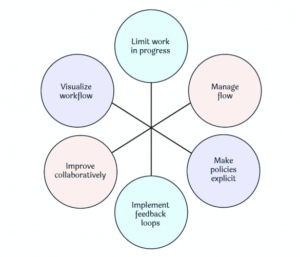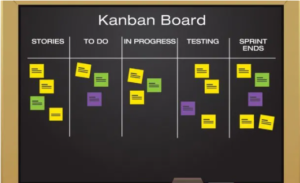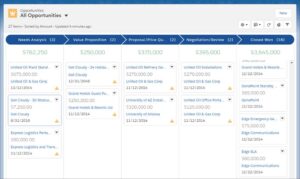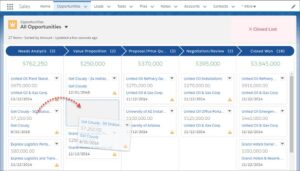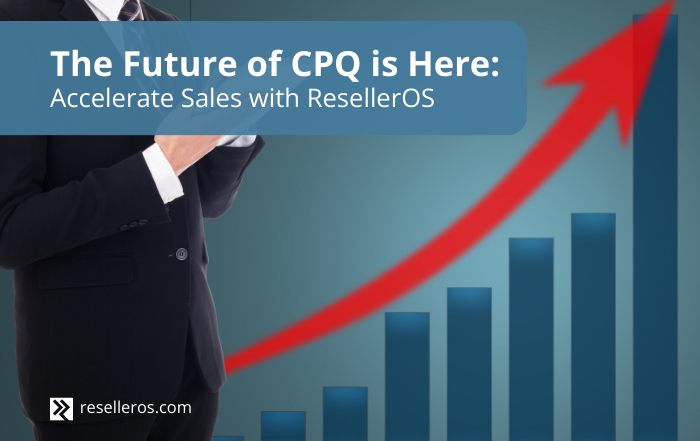How to Enable Kanban View in Salesforce
Salesforce empowers sales organizations to optimize their pipelines by staying data-informed, accessing information in real time, and collaborating effectively across teams. One of the most powerful (and often underutilized) ways it does this is through the Kanban View.
Salesforce Kanban View gives sales teams a high-level visualization of the entire sales pipeline, enabling them to easily see, edit, and move opportunities through its stages, see the number of deals and total dollar amounts tied up in each stage, and collaborate to keep opportunities moving forward.
When used effectively, Kanban can seriously elevate your team’s pipeline management efficiency by powering collaboration, creating accountability, and keeping teams and managers informed at a higher level.
Let’s take a deeper look at the Kanban methodology and how you can start using it today in your Salesforce Lightning platform.
What is Kanban anyway?
Kanban Origins
Kanban is a Japanese word meaning “visual signal,” and the first Kanban system was developed by industrial engineer and businessman Taiichi Ohno, who implemented it as a planning system for Toyota automotive in the 1940s.
Toyota used Kanban to better align inventory and consumption on its factory floors. Today it’s used across many industries and even by individuals for personal time management. It’s most widely known as an agile method used by software development teams to increase flexibility, accelerate output, and stay more transparent throughout the development cycle.
The Kanban Method
The Kanban Method is a pull system designed to optimize workflow and resources. To this end, Kanban is centered around six core practices.
The method itself is practiced by focusing on the parts of the workflow — in general: to do, in progress, and completed. Workflows can be adjusted or built to meet the specific needs of the team.
Kanban Boards
A Kanban board is the visual tool used to actually practice the Kanban methodology. It relies on visual signals (like post-its) to move products and projects through the workflow columns on the board. Boards can be physical or virtual, and while some prefer a physical board, virtual boards offer collaborative 24/7 accessibility from any location that’s integral for many teams today.
The purpose of the Kanban board is to make the workflow visual and standardized so that teams can work in real time to continuously complete tasks, identify and resolve issues, and communicate to improve processes.
Kanban as a Powerful Salesforce Tool
Kanban can be used for almost any object in Salesforce and is a powerful, visual way to bring together teams around initiatives, tasks, user stories, features, or other “work units” to prioritize and report progress.
- Planning/managing features in a product release (apps like LEXIdeas by Rainmaker are a great way to source ideas for new features)
- Managing development work like user stories (used in agile methodology to describe a feature from a user point of view) and tasks (provide to-do items that need to be completed) in a collaborative way
- Collaborating on video or content production within a media production team
- Visualizing opportunities within pipeline stages
How to Enable Kanban View in Salesforce
Kanban View provides a high-level visual summary of all opportunities within a sales path and gives sales reps a better ability to manage the entire pipeline and keep deals moving forward at the right pace. Kanban also gives sales managers a way to track performance and ensure reps are on course.
Here’s what it looks like in the platform:
Kanban view is available in Salesforce Lightning and can be enabled using the following steps:
- Click the “Opportunities” tab
- Select “All Opportunities” list view
- Open the “Display As” menu and select Kanban
Once the Kanban view is enabled, card fields can be customized using List View Controls and filters can be added to adjust board parameters. Kanban boards can be filtered by team, user, region, and more.
In Kanban view, opportunities can easily be moved between stages and dollar amounts in each stage will automatically update, giving sales reps and managers valuable insight into the amounts tied up in each stage of the pipeline.
Kanban cards can be edited at any time, and users are prompted to take action when any opportunity has no activity or tasks attached to it, ensuring opportunities don’t get stuck sitting in the pipeline or fall through the cracks.
Users in Kanban view can also create charts or add filters to create different views like, for example, viewing all opportunities in the pipeline for a particular account. And while Salesforce organizes the Kanban board by default according to stage, this can be adjusted for different preferences, too (for example, by deal type or delivery status). Stages can then be summarized differently as well (like by expected revenue rather than deal value).
Leverage Salesforce to Power Sales
Salesforce empowers sales organizations with integrative, collaborative tools and data-driven insights. If you’re looking to adopt Salesforce for your organization or customize your existing Salesforce experience, Rainmaker has solutions that can help. Contact us today to learn more!
Related Resources
The Future of CPQ Is Here: Accelerate Sales with ResellerOS
The Future of CPQ Is Here: Accelerate Sales with ResellerOS Welcome to ResellerOS, your trusted partner in revolutionizing Revenue Operations with our Ultimate User-Friendly CPQ Tool Suite. In this comprehensive
The 1-2-3 Guide to Resource Capacity Planning with Salesforce
The 1-2-3 Guide to Resource Capacity Planning with Salesforce Studies show that 67% of business project failures result from insufficient and undervalued project management and planning. As inflation and rising resource costs continue to
4 SFDC Integration Best Practices You Need to Know
4 SFDC Integration Best Practices You Need to Know In 2017, enterprises used an average of just 16 software-as-a-service (SaaS) applications. By 2021, that number had swelled to 110. While microservices offer companies scalability,
How to Perfect Your Change Management Process
How to Perfect Your Change Management Process The capacity to adapt to ongoing changes is a critical part of long-term business success. Whether it's unanticipated economic disruption, the rise of new competition, or new
5 Salesforce Data Migration Tools to Speed Up Your M&A
5 Salesforce Data Migration Tools to Speed Up Your M&A Mergers and acquisitions are an eventual part of business growth. Nevertheless, organizations manage their records and customer data according to methods that suit their
Perfecting Your Salesforce UX for Sales Reps and Agents
Perfecting Your Salesforce UX for Sales Reps and Agents In 2009, an epidemic of Toyota drivers uncontrollably accelerating broke into the mainstream as a 911 call of a man who couldn't slow down his


